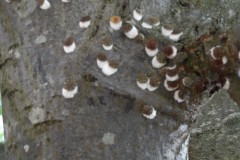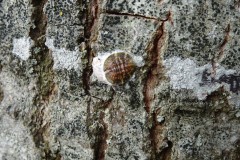The Horse-chestnut scale insect Pulvinaria regalis: a new resident on Doncaster’s Lakeside Boulevard.
Nora Boyle & C.A. Howes
On 4 May, after a chilly walk round the islands of Doncaster Lakeside, looking at nesting Coots, courting Great-crested Grebes, insect-hawking House Martins and a rather sluggish Terrapin, an even more fascinating observation awaited.
On returning to the adjacent Lakeside Boulevard (SE596018) and while examining a range of insect galls on the foliage of the roadside trees, a rather conspicuous colony of a scale insect (see figure 1) was encountered on a Silver Lime Tree Tilia tomentosa. The colony, made conspicuous by their pristine white egg cocoons, was concentrated above head height on the main trunk and bases of lower branches. These turned out to be the waxy egg cocoons and adults of Pulvinaria regalis the so called Horse-chestnut scale insect (see figure 2), a recent immigrant to the UK fauna.
Figure 1. Colony of Scale insect egg cocoons and adult females on trunk and base of lower branch of Silver Lime on Lakeside Boulevard, Doncaster. Photo by Nora Boyle
Figure 2. Single adult female Pulvinaria regalis on egg cocoon on bark of Silver Lime tree on Lakeside Boulevard, Doncaster. Photo by Nora Boyle.
This Bug (Hemipteran) of the sub order Homoptera, belongs to the sap-sucking family Coccidae which includes the scale insects, tortoise scales and mealy bugs. Pulvinaria regalis is thought to have originated in Asia, spreading to Europe as recently as the second half of the twentieth century (internet ref. 1). It was first noticed in the UK in the London Boroughs in the 1960s, swiftly spreading through southern England evidently reaching Yorkshire and Lancashire by 2005 (Brighton & Hove City Council, 2005).
The known hosts for this scale insect include some 65 taxa but its main host species are Horse-chestnut, Sycamore, Maple, Lime, Elm, Magnolia, Bay and Dogwood (Internet ref. 1).
It thrives particularly on trees in urban situations such as those planted by local authorities and property developers along roadside verges on major vehicular routes, paved squares and car parks (Brighton & Hove City Council, 2005). In these circumstances the host trees are subject to elevated temperatures, air pollution, lower availability of nutrients, and stress caused by lack of moisture (more run-off and less water penetrating the ground) (Internet ref. 1).
Since the female insects are wingless and are therefore unable to fly, their means of geographical dispersal are likely to be on commercial nursery stock or on tree prunings. This may explain their rapid yet somewhat discontinuous pattern of spread (Internet ref. 1). Studies in urban Oxford showed that Scale insect pest densities increase in trees experiencing stress through impermeability of substrate, reducing water and nutrients availability. Trees closer to buildings also showed higher pest densities (Speight et al, 1998).
On 6 May CAH revisited the Lakeside development and checked for infestations on the whole population of roadside trees, commencing at the roundabout linking to Gliwici Way SE595019 and terminating at the roundabout linking with Wilmington Drive SE591014, a distance of 1.06 Km. Of 120 trees, 57 (48%) had been colonised by Pulvinaria regalis. The most frequent of the roadside trees were Silver Limes (n 80), 53 (66%) of which were colonised. Of the 33 Maples Acer sp., just 2 (6%) of which had been colonised but of the 7 Horse chestnuts Aesculus hippocastanum 2 (29%) had been colonised.
It will be interesting to see if insectivorous birds and predatory invertebrates adapt to utilise this new food resource.
Stuart Foster, Hemiptera recorder for the YNU and who has spoken to the Doncaster Nats on various occasions on the subject of plant bugs, has kindly contributed his local encounters with Pulvinaria regalis and its near relatives as follows.
“I have found Pulvinaria regalis in Edenthorpe on several occasions in the past ten years on Thorne Road, Mere Lane and in my garden on Acer sp. with massive infestations on Sycamore Acer pseudoplatanus. It is probably very well established in our area but appears to be variable in its population density year on year. I have also observed Pulvinaria floccifera on Camelia in my garden, and Pulvaria hydrangeae on Hydrangea in a garden on Cedric Road, Edenthorpe; all within the same time period.”
Other records of Pulvinaria regalis occurrences in the Yorkshire region (see appendix 1) have been gleaned from iNaturalist; iSpot and the NBN Gateway atlas.
Stress evidence. With the Lakeside development having been established on a substrate of Triassic Sherwood sand (fossil sand dunes), pipework had been provided adjacent to each roadside tree, enabling bowser-watering for the first few years of growth. However, some drought-stress evidently remained a feature since there were odd gaps in the tree lines and 6 standing dead specimens were present during the current survey.
References
(Internet ref. 1) https://www.inaturalist.org/taxa/59960-Pulvinaria-regalis.
Brighton & Hove City Council (2005) Arboricultural Information Note No. 8 Horse Chestnut Scale
(Pulvinaria regalis).
Speight, M.R., Hails, R.S., Gilbert, M. & Foggo. A. (1998). Horse Chestnut Scale (Pulvinaria
regalis Homoptera: Coccidae) and Urban Host Tree Environment (PDF). Ecology
79 (5): 1503–1513.
| Yorkshire Records | Date | Recorder | Source |
|---|---|---|---|
| Yorkshire (no data) | 2005 | Brighton & Hove City Council (2005) | |
| Scarborough area TA08 (VC62) | 10.06.2012 | Yashka | iSpot; NBN Atlas |
| Carr Lane Primary TA03 (VC61) | 06.06.2013 | iNaturalist; iSpot | |
| Wildlife Garden, Hull, TA08253015 (VC61) | 19.07.2014 | Bob Jacques | iNaturalist; NBN Atlas |
| Sheffield (VC63) | 21.05.2019 | Jennifer17 | iNaturalist |
| Old Hall Bridge, Barnsley (VC63) | 31.05.2019 | Kit Beard | iNaturalist |
| North Road, Kirkburton, Huddersfield (VC63) | 03.06.2019 | Charlotte211 | iNaturalist |
| Barnsley S70 2EZ (VC63) | 13.06.2019 | Kit Beard | iNaturalist |
| Marlborough Avenue | 16.05.2020 | Julian Has | iNaturalist |
| Anlaby Park Hull, HU4 (VC61) | 24.05.2023 | Andy Donegan | iNaturalist |
| MKM Stadium, Willerby, Hull (VC61) | 29.09.2023 | Andy Donegan | iNaturalist |
| Lakeside Boulevard, Doncaster SE596018 (VC63) | 04.05.2025 | Nora Boyle & C.A. Howes | This study |
C.A. Howes (May 2025)

